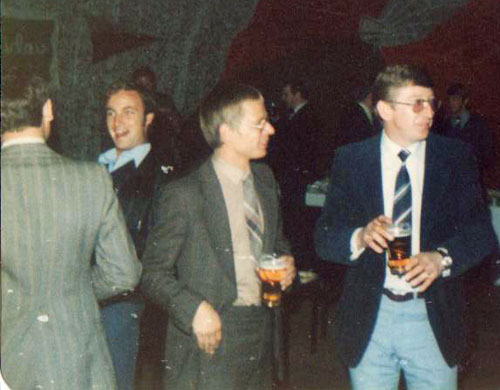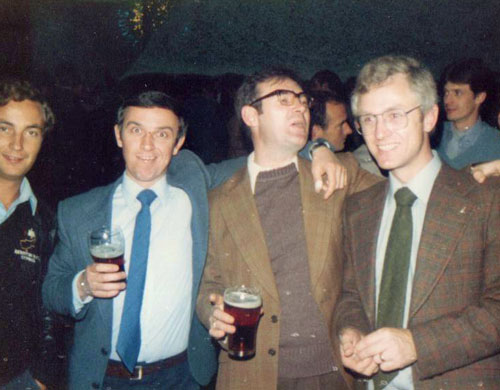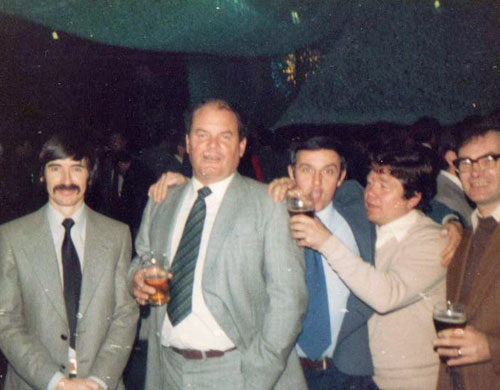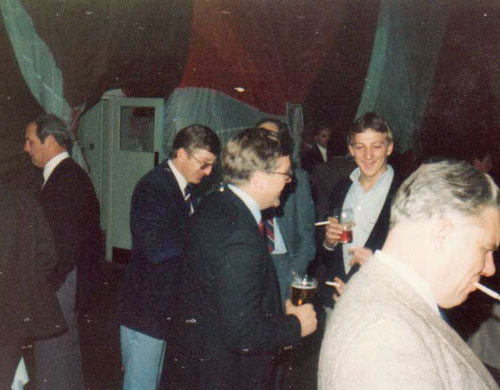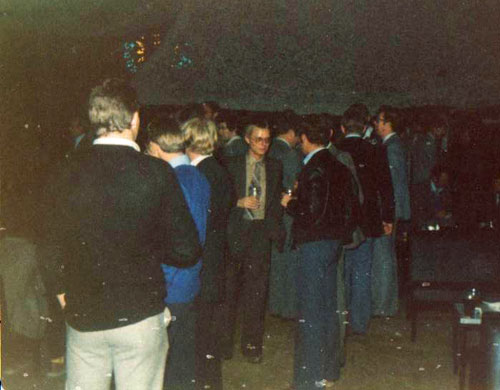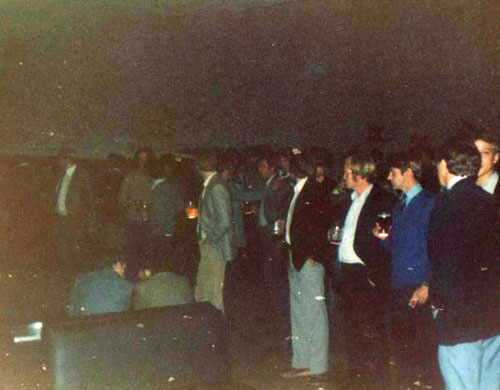
From: Duncan Grant, Trentham, Staffs
Sent: Thursday, March 27, 2014 6:11 PM
Subject: RAF Mystery Photo 032814
Tony,
What a great selection for the RAF photo. Of course it was at BZZ with the great and the not so good meeting last month.
What an opportunity for a caption competition! Was it the start of a high five? Was the Gp Capt about to swat a fly to stop it landing on the French President's nose? Was he calling up the car? Was he waving to the wife? The ideas are endless!
Another great read. How do you manage to keep it so current (eg the Voyager article)
Many thanks
Duncan Grant
Sent: Thursday, March 27, 2014 6:11 PM
Subject: RAF Mystery Photo 032814
Tony,
What a great selection for the RAF photo. Of course it was at BZZ with the great and the not so good meeting last month.
What an opportunity for a caption competition! Was it the start of a high five? Was the Gp Capt about to swat a fly to stop it landing on the French President's nose? Was he calling up the car? Was he waving to the wife? The ideas are endless!
Another great read. How do you manage to keep it so current (eg the Voyager article)
Many thanks
Duncan Grant
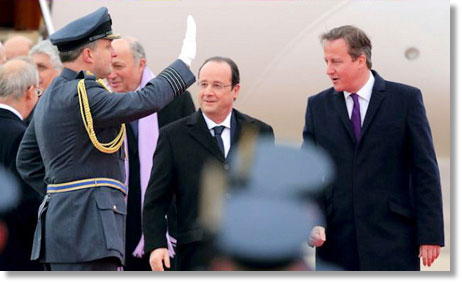
From: Kevin Skinner, Limassol
Sent: Friday, March 28, 2014 6:47 AM
Subject: RE: UKMAMS OBA OBB #032814
Tony,
RAF Mystery photo is of the Brize Norton Station Commander Gp Capt Steve Lushington clearly left hanging for a 'high five' by the Prime Minister and French President at the recent Anglo French Summit held at RAF Brize Norton. Perhaps he may have been paying compliments at that particular moment!
Thanks for Newsletters, keep up the good work.
Regards
Kev Skinner
Joint Movements Sqn
Akrotiri
Sent: Friday, March 28, 2014 6:47 AM
Subject: RE: UKMAMS OBA OBB #032814
Tony,
RAF Mystery photo is of the Brize Norton Station Commander Gp Capt Steve Lushington clearly left hanging for a 'high five' by the Prime Minister and French President at the recent Anglo French Summit held at RAF Brize Norton. Perhaps he may have been paying compliments at that particular moment!
Thanks for Newsletters, keep up the good work.
Regards
Kev Skinner
Joint Movements Sqn
Akrotiri
From: Charles Collier, Ewhurst, Surrey
Sent: Saturday, March 29, 2014 8:11 AM
Subject: RAF Mystery Photo 032814
Hi Tony,
The RAF photo is of Prime Minister David Cameron and President Francois Hollande of France at a recent EU summit and I guess that with the Gp Capt about to salute that it took place at RAF Northolt on the arrival of the French president to be greeted by David Cameron.
All the best to everyone
Charles
Sent: Saturday, March 29, 2014 8:11 AM
Subject: RAF Mystery Photo 032814
Hi Tony,
The RAF photo is of Prime Minister David Cameron and President Francois Hollande of France at a recent EU summit and I guess that with the Gp Capt about to salute that it took place at RAF Northolt on the arrival of the French president to be greeted by David Cameron.
All the best to everyone
Charles

As suggested, the RAF Mystery Photo from last month's edition would make a great subject for a caption competition!
The competition is open to one and all and you may enter as often as you like. The closing date will be Wednesday, 28th May 2014.
The competition is open to one and all and you may enter as often as you like. The closing date will be Wednesday, 28th May 2014.
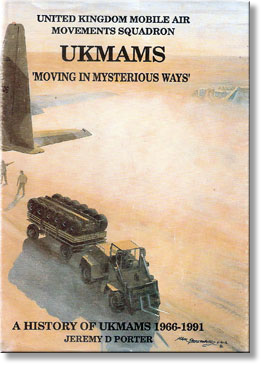
You, the readers, will be the judges of the winning entry by means of an online form that will be in the May 30th newsletter. The winner's name will be announced in the June 27th newsletter.
The first prize will be the book "UKMAMS, Moving in Mysterious Ways" (retail value = Priceless!)
The first prize will be the book "UKMAMS, Moving in Mysterious Ways" (retail value = Priceless!)
(Thanks to Ian Berry for supplying the prize)
Send your entry to:
ukmamsoba@gmail.com
From: Duane Bach, Carrying Place, ON
Sent: Thursday, March 27, 2014 10:23 PM
Subject: Thanks
Hi Tony,
Thank you for the dedication to Pete Murphy (Murph the Surf). I had the privilege of meeting, working and drinking with him.... he actually brought a mallard duck on board an aircraft and had the seat booked in accordance with military regulations... it's name was Cpl Drake.... and so it goes... he was a Good Man with a hellava sense of humour... A True Mover ...
Cheers, Duane
Sent: Thursday, March 27, 2014 10:23 PM
Subject: Thanks
Hi Tony,
Thank you for the dedication to Pete Murphy (Murph the Surf). I had the privilege of meeting, working and drinking with him.... he actually brought a mallard duck on board an aircraft and had the seat booked in accordance with military regulations... it's name was Cpl Drake.... and so it goes... he was a Good Man with a hellava sense of humour... A True Mover ...
Cheers, Duane
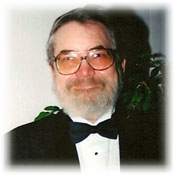
From: Victor Smith, Brassall, QLD
Sent: Saturday, March 29, 2014 1:14 AM
Subject: Scariest Flight
Sent: Saturday, March 29, 2014 1:14 AM
Subject: Scariest Flight
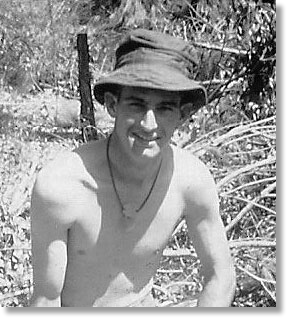
Thanks again for a great read Tony.
On the subject of scariest flights, albeit a few years before I became involved in the Air Movements game. I was a door gunner with RAAF 9Sqn on UH1H helicopters.
On this particular day we had been tasked to fly the Brigadier from Nui Dat to Tan Son Nhut airport, Saigon. To say the least, the weather was crappy. I cannot remember what the flying time was supposed to be but, as we got closer and closer to Tan Son Nhut, the weather got worse and worse. From memory, we were within 5 minutes flying time from what was then possibly the most active airfield in the world and visibility was down to less than 5 yards.
Around that point the aircraft captain told the Brigadier we were returning to Nui Dat and we did so. On return, the Brigadier grabbed a lift on a 35SQN Caribou and eventually made the flight he was supposed to catch. But for quite a few minutes of that flight of ours there was one very nervous door gunner.
Cheers, Vic
On the subject of scariest flights, albeit a few years before I became involved in the Air Movements game. I was a door gunner with RAAF 9Sqn on UH1H helicopters.
On this particular day we had been tasked to fly the Brigadier from Nui Dat to Tan Son Nhut airport, Saigon. To say the least, the weather was crappy. I cannot remember what the flying time was supposed to be but, as we got closer and closer to Tan Son Nhut, the weather got worse and worse. From memory, we were within 5 minutes flying time from what was then possibly the most active airfield in the world and visibility was down to less than 5 yards.
Around that point the aircraft captain told the Brigadier we were returning to Nui Dat and we did so. On return, the Brigadier grabbed a lift on a 35SQN Caribou and eventually made the flight he was supposed to catch. But for quite a few minutes of that flight of ours there was one very nervous door gunner.
Cheers, Vic
From: Brian Harper, Glenwood, NL
Sent: Monday, March 31, 2014 3:13 PM
Subject: UKMAMS Photos
Sent: Monday, March 31, 2014 3:13 PM
Subject: UKMAMS Photos
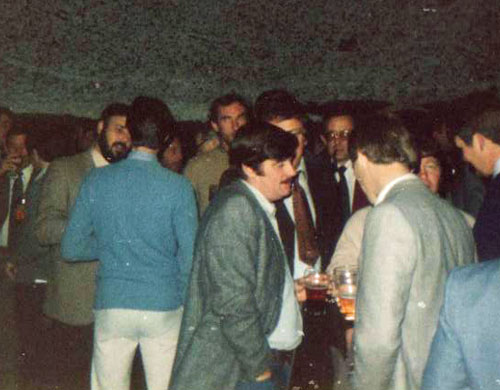
Hi Tony,
I recently came across these photos tucked away in an old album. They were taken at a MAMS bash back in 1980.
Brian
I recently came across these photos tucked away in an old album. They were taken at a MAMS bash back in 1980.
Brian
From: Charlie Gibson, Monifieth, Dundee
Sent: Thursday, April 03, 2014 1:28 PM
Subject: Inside RAF Brize Norton
Sent: Thursday, April 03, 2014 1:28 PM
Subject: Inside RAF Brize Norton
I have been watching a program on TV about RAF Brize Norton, it was a mini series. The last program showed Air Movers Training and what shocked and amazed me was that trainees were called “Baby Movers”.
I have been called many things in The Mob and in Civie Street but if any of the guys I trained and worked with were ever described as Baby Movers there would have been a big queue at SSQ!
Chas Gibson
I have been called many things in The Mob and in Civie Street but if any of the guys I trained and worked with were ever described as Baby Movers there would have been a big queue at SSQ!
Chas Gibson

From: Bob Dixon, Dauntsey, Wilts
Sent: Wednesday, April 09, 2014 5:45 AM
Subject: Neil Mackay
[Edited for content]
Sent: Wednesday, April 09, 2014 5:45 AM
Subject: Neil Mackay
[Edited for content]
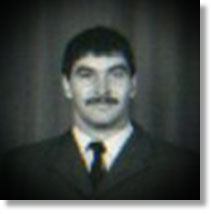
Neil Mackay unexpectedly died on Friday 28 March following a heart attack. I have known and worked with Neil in the Movements and the Fuels world and I was also was involved with his achieving the dream of living and working in the Caribbean.
I shall never forget his secret arrangements for my departure from the RAF; determined that I should not leave from my London MoD office via the local pub, he set up a superb dinner for me and many Service friends at RAF Lyneham.
Neil was on UKMAMS as a Team Leader and left the RAF as a Sqn Ldr, going on to become a diving instructor in the US Virgin Islands for several years before returning to this area, most recently living in Melksham. His family are in South Africa.
I shall never forget his secret arrangements for my departure from the RAF; determined that I should not leave from my London MoD office via the local pub, he set up a superb dinner for me and many Service friends at RAF Lyneham.
Neil was on UKMAMS as a Team Leader and left the RAF as a Sqn Ldr, going on to become a diving instructor in the US Virgin Islands for several years before returning to this area, most recently living in Melksham. His family are in South Africa.
From: Andrew Gell
Sent: Saturday, April 05, 2014 9:12 AM
Subject: Neil Mackay
Dear Bob,
Thank you for getting the word out, through Tony, about the sad and untimely death of Neil Mackay. Please pass my sincere condolences to Ruth.
Neil and I worked together as junior officers at Lyneham and I recognise the picture of a direct and enthusiastic man that you paint. He was a true character and life was never dull when Neil was around. Although I have spoken to him at the occasional Movers’ Reunion in recent years, my last memory of Neil in uniform comes from towards the end of his RAF career when his plans to become a diving instructor were beginning to take shape.
I was Senior Air Movements Officer at Akrotiri and one afternoon Neil burst into my office demanding coffee and a chat. Unbeknownst to me he was on a flight flagging Akrotiri - I can’t recall where from or to - and had a couple of hours on the ground to kill. This would have been in the mid-90s, but I can still clearly remember him creating a vivid and attractive picture of what his future life, in the sun and passing on his love of diving to others, was going to be like. I am glad that he was given the chance to live that dream.
Best wishes,
Andy Gell
Sent: Saturday, April 05, 2014 9:12 AM
Subject: Neil Mackay
Dear Bob,
Thank you for getting the word out, through Tony, about the sad and untimely death of Neil Mackay. Please pass my sincere condolences to Ruth.
Neil and I worked together as junior officers at Lyneham and I recognise the picture of a direct and enthusiastic man that you paint. He was a true character and life was never dull when Neil was around. Although I have spoken to him at the occasional Movers’ Reunion in recent years, my last memory of Neil in uniform comes from towards the end of his RAF career when his plans to become a diving instructor were beginning to take shape.
I was Senior Air Movements Officer at Akrotiri and one afternoon Neil burst into my office demanding coffee and a chat. Unbeknownst to me he was on a flight flagging Akrotiri - I can’t recall where from or to - and had a couple of hours on the ground to kill. This would have been in the mid-90s, but I can still clearly remember him creating a vivid and attractive picture of what his future life, in the sun and passing on his love of diving to others, was going to be like. I am glad that he was given the chance to live that dream.
Best wishes,
Andy Gell
From: Alexander Angus, Glasgow
Sent: Tuesday, April 08, 2014 5:47 AM
Subject: Phillip Clarke & Some Stuff
Hi Tony,
Yep its been over a decade since the last contact! This email is the result of a sequence of events after a phone call, out of the blue, from David Moss informing me of the sad passing of Phillip "Nobby" Clarke after battling cancer.
After he'd rung off, and the info had sunk in, I realised that I could not send condolences as I had no idea as to his family's whereabouts. The last time we had spoken (40th Reunion) I think he was still based in Vienna. I think his parents were in the Bolton area but that was all I knew.
That got me wondering how David had got my phone number (maybe he has contacts in the Police Force - oops that's not a nice thing to say about anyone ha ha). So I set about researching (as best as my ability allowed) and found the UKMAMSOBA.
Hopefully through the OBA my condolences can be passed to Phil's family, also, belatedly, to Mike Tookey's family as well (Mike was on D'Shift KSR with me).
Sent: Tuesday, April 08, 2014 5:47 AM
Subject: Phillip Clarke & Some Stuff
Hi Tony,
Yep its been over a decade since the last contact! This email is the result of a sequence of events after a phone call, out of the blue, from David Moss informing me of the sad passing of Phillip "Nobby" Clarke after battling cancer.
After he'd rung off, and the info had sunk in, I realised that I could not send condolences as I had no idea as to his family's whereabouts. The last time we had spoken (40th Reunion) I think he was still based in Vienna. I think his parents were in the Bolton area but that was all I knew.
That got me wondering how David had got my phone number (maybe he has contacts in the Police Force - oops that's not a nice thing to say about anyone ha ha). So I set about researching (as best as my ability allowed) and found the UKMAMSOBA.
Hopefully through the OBA my condolences can be passed to Phil's family, also, belatedly, to Mike Tookey's family as well (Mike was on D'Shift KSR with me).
Bob
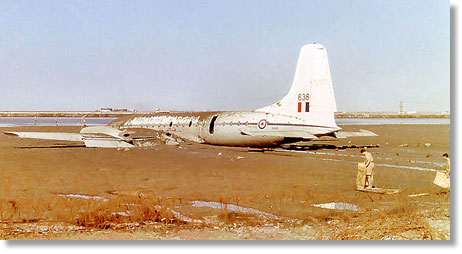
That then kicked in other thoughts, one of which was the following: On 12 October 1967, Khormaksar, Britannia 638 went off the end of the runway into the mud (which was sticky and stank). Our DAMO sent me and one other to recover the DIP mail (smelly and dirty but no problem).
On the walk back to MOVs (no chance of a lift with smell and mud) the DAMO came back to us and told us to go back and find a missing passenger. Trepidation taking over, we returned but after a massive search found nothing - turns out the git was in Neddy's knocking back the booze!!!!
My question, however, is who the hell was with me as the mists of time are almost impenetrable (and not just at that point). Hoping that I'm not the only one that remembers this incident.
On the walk back to MOVs (no chance of a lift with smell and mud) the DAMO came back to us and told us to go back and find a missing passenger. Trepidation taking over, we returned but after a massive search found nothing - turns out the git was in Neddy's knocking back the booze!!!!
My question, however, is who the hell was with me as the mists of time are almost impenetrable (and not just at that point). Hoping that I'm not the only one that remembers this incident.
Further to John Philps missive of 1/5/2013, yep too late for 50th/50th Reunion September 2013 but maybe he could consider April 2015 as our graduation - could be worthwhile. My own inability to get it going is because, as President of the Kippax & District Branch of The Royal British Legion, we have an awful lot going on in 2014/2015 with the commemoration of the centenary anniversary of the outbreak of WWI, the D-Day 70th Anniversary and the anniveraries of VE and VJ days next year - but just a thought for John.
Anyway, great website Tony and I reckon there could be further communication in the future.
All the very best
Alec
Anyway, great website Tony and I reckon there could be further communication in the future.
All the very best
Alec
From: Al Gordon, St. Albert, AB
Sent: Tuesday, April 08, 2014 12:19 PM
Subject: A Memorable Flight
Hi Tony,
A Memorable Flight… Lest We Forget
I would think that most of us who spent time on flying duties have had a flight or two that is etched in our memories. It could have been something that happened that scared us or maybe it caused us to reflect and learn one of those life lessons you can’t learn in the classroom, or maybe it’s the extra ordinary nature of the flight and the priceless value of the load makes it memorable.
Sent: Tuesday, April 08, 2014 12:19 PM
Subject: A Memorable Flight
Hi Tony,
A Memorable Flight… Lest We Forget
I would think that most of us who spent time on flying duties have had a flight or two that is etched in our memories. It could have been something that happened that scared us or maybe it caused us to reflect and learn one of those life lessons you can’t learn in the classroom, or maybe it’s the extra ordinary nature of the flight and the priceless value of the load makes it memorable.

In August 1974 I was stationed at 436(T) Squadron Trenton on C-130s. My co-loadmaster, Brian Shearon, and I were flying slip crew out of Lahr, Germany; I was still a restricted Loadmaster. On the leg from Lahr to Akrotiri, Cyprus, Brian gave me my operational check. I passed and felt that I had really earned my wings and was ready to take on the world!
On arrival at Akrotiri, we were diverted to Cairo to wait for clearances to fly into Damascus. Word had reached us that one of our U.N. aircraft, Buffalo 115461, had been shot down by three Syrian surface-to-air missiles. The aircraft and crew had been stationed in Egypt and were flying U.N. support in the Middle East. There had been eight Canadian crew and passengers on board.
On arrival at Akrotiri, we were diverted to Cairo to wait for clearances to fly into Damascus. Word had reached us that one of our U.N. aircraft, Buffalo 115461, had been shot down by three Syrian surface-to-air missiles. The aircraft and crew had been stationed in Egypt and were flying U.N. support in the Middle East. There had been eight Canadian crew and passengers on board.
After a one-day delay we received clearances for a late afternoon flight to Damascus to retrieve the remains of our service men. We knew few details surrounding the events leading up to 461 being shot down other than we would be flying into to Damascus on the same route they had flown. It was a tense flight and we arrived in Syrian airspace after dark. Syrian traffic control gave what seemed to be numerous and restrictive flight directions with no room for deviation. All eyes were peering out into the dark in case anything out of the ordinary could be seen. I was standing behind the left seat. After about twenty intense minutes we turned on our final approach and were directed to turn the landing lights on. By now it seemed that there was more adrenaline running through our veins than blood. When the landing lights were turned on and rotated forward we all saw a heart stopping white flash coming from the lower left and streaking over the cockpit. I have since been on other flights and bird strikes or near bird strikes have never had that effect on the crew. I think that we came down to earth five minutes after we landed.
On the tarmac we were met by two small but respectful Honour Guards; Syrian and Canadian. After the short ramp ceremony the caskets of the eight Canadians were loaded on board along with numerous floral wreaths in memory of the airmen and soldiers. As the Honour Guards left, I started to throw the wreaths off the plane. Brian asked what hell I was doing. I, the newly operational loadmaster, informed him about transporting vegetation from one country to another. He took me aside and told me to close up the cargo compartment and this could be dealt with in Lahr. With our precious load secured we had a very quiet and somber flight back to Lahr.
On the tarmac we were met by two small but respectful Honour Guards; Syrian and Canadian. After the short ramp ceremony the caskets of the eight Canadians were loaded on board along with numerous floral wreaths in memory of the airmen and soldiers. As the Honour Guards left, I started to throw the wreaths off the plane. Brian asked what hell I was doing. I, the newly operational loadmaster, informed him about transporting vegetation from one country to another. He took me aside and told me to close up the cargo compartment and this could be dealt with in Lahr. With our precious load secured we had a very quiet and somber flight back to Lahr.
Although this flight was tense with a moment of panic, it was truly memorable and life changing for many other reasons. It brought home to me the reality of the work that we do and the necessity to live each day the best we can. It taught me that rules should sometimes be broken. It also taught me that at the end of the day when the Honour Guard, politicians, and media have gone home the only ones who truly remember the sacrifices that many have made, outside immediate family, is our trade and military family. Those who have gone before us remain in our hearts and collective memories. We don’t forget.
For those who might be interested in the details of 115461 please check out the following link: www.buffalo461.ca/buffalo461.htm
For those who might be interested in the details of 115461 please check out the following link: www.buffalo461.ca/buffalo461.htm
From: John Holloway, Shrewsbury
Sent: Tuesday, April 08, 2014 5:10 PM
Subject: NSRAFA Cosford
Hi Tony,
Today's Cosford get-together went down well with 39 members and guests attending.
Our speaker was Tony Hearne, ex-Army and well into his late 80s who gave us a talk on India and the Raj. First a little on the history of how we had to take on the other European nations especially the French. Of course trade was the main interest of our being there and as we know in it's time it was known as the Jewel of the Empire.
Sent: Tuesday, April 08, 2014 5:10 PM
Subject: NSRAFA Cosford
Hi Tony,
Today's Cosford get-together went down well with 39 members and guests attending.
Our speaker was Tony Hearne, ex-Army and well into his late 80s who gave us a talk on India and the Raj. First a little on the history of how we had to take on the other European nations especially the French. Of course trade was the main interest of our being there and as we know in it's time it was known as the Jewel of the Empire.
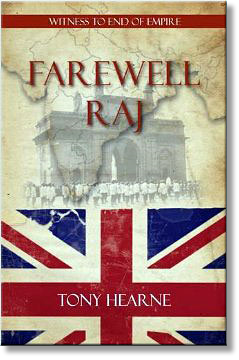
He was born in Lahore, which is now in Pakistan; his father was a Provincial Civil Servant. He joined the Army in 1943. He told us what happened in 1947 when India got its independance and Pakistan came into being. He told us about the atrocties that were carried out with Hindus fleeing Pakistan and Moslems fleeing India.
He has written a book, Farewell Raj, in which he describes his train journey across India, from Calcutta and ending in Lahore, across the new border in Pakistan.
I had a personal chat with him, as I had been stationed in Pakistan, about my trip up north to Lahore, Rawlapindi and the Murree Hills. He recalled that there was a brewery there and I was able to tell him that it is still there, even brewing its own brand of whiskey and it is still known as Murree Brewery. I got him to talk about the snakes that are there and where thousands of people die each year as a result of bites from Cobras and Kraits.
He spoke of much that we took from India but also the things we left for them, for example: irrigation systems, canals, railways and democracy amongst other things, not at all like the other European nations that did nothing for them.
On closing we all gave him a rousing applause as his talk was most entertaining, especially for me to be able to talk to him about my time in Pakistan.
Cheers
John
He has written a book, Farewell Raj, in which he describes his train journey across India, from Calcutta and ending in Lahore, across the new border in Pakistan.
I had a personal chat with him, as I had been stationed in Pakistan, about my trip up north to Lahore, Rawlapindi and the Murree Hills. He recalled that there was a brewery there and I was able to tell him that it is still there, even brewing its own brand of whiskey and it is still known as Murree Brewery. I got him to talk about the snakes that are there and where thousands of people die each year as a result of bites from Cobras and Kraits.
He spoke of much that we took from India but also the things we left for them, for example: irrigation systems, canals, railways and democracy amongst other things, not at all like the other European nations that did nothing for them.
On closing we all gave him a rousing applause as his talk was most entertaining, especially for me to be able to talk to him about my time in Pakistan.
Cheers
John
From: Jeremy Babington
Sent: Sunday, April 13, 2014 1:22 PM
Subject: Most Memorable Tasks
Tony,
2 bad ‘uns to give you!
Sent: Sunday, April 13, 2014 1:22 PM
Subject: Most Memorable Tasks
Tony,
2 bad ‘uns to give you!
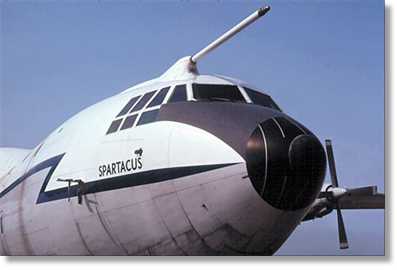
27 March 1976. Trip to Bardufoss on board Belfast XR 369 to recover RE wrecker with Bravo team. On arrival discovered that said wrecker was u/s. Belfast winch not up to the job of loading.
Flight Sergeant John Illsley (best SNCO I ever had the privilege of working for!) suggested I go for a cup of tea in ATC. As usual, I did as he said.
An hour later returned to the aircraft to find the wrecker loaded and restrained. It would appear that John had requested the aid of not one but two Norwegian Army wreckers to push the RE wrecker onto the Belfast.
Yet another near career “wrecking incident” successfully avoided. No idea how BZZ movers offloaded the thing! Bravo John!
Flight Sergeant John Illsley (best SNCO I ever had the privilege of working for!) suggested I go for a cup of tea in ATC. As usual, I did as he said.
An hour later returned to the aircraft to find the wrecker loaded and restrained. It would appear that John had requested the aid of not one but two Norwegian Army wreckers to push the RE wrecker onto the Belfast.
Yet another near career “wrecking incident” successfully avoided. No idea how BZZ movers offloaded the thing! Bravo John!
17 August 1976. Trip to Masroor Pakistani Air Base near Karachi on XV 182 via Luqa to recover 13 Sqn (Canberra PR) detachment. Spent 3 days in Karachi and in so doing contracted dysentery.
Return flight was by Belfast XR 364 via Teheran. No pills, Belfast went u/s in Teheran so spent 48 hours there in the Holiday Inn sat on the loo!
Eventually got back to Luqa to see the doc. Lost 2 stone! (28 Lbs)
Cheers,
Jerry
Return flight was by Belfast XR 364 via Teheran. No pills, Belfast went u/s in Teheran so spent 48 hours there in the Holiday Inn sat on the loo!
Eventually got back to Luqa to see the doc. Lost 2 stone! (28 Lbs)
Cheers,
Jerry
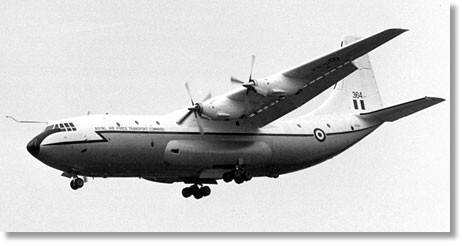
From: John Holloway, Shrewsbury
Sent: Monday, April 14, 2014 10:39 AM
Subject: Most Memorable Tasks
Hi Tony
A couple of tasks that I was involved in may seem a bit mundane but I was the only one doing them.
Sent: Monday, April 14, 2014 10:39 AM
Subject: Most Memorable Tasks
Hi Tony
A couple of tasks that I was involved in may seem a bit mundane but I was the only one doing them.
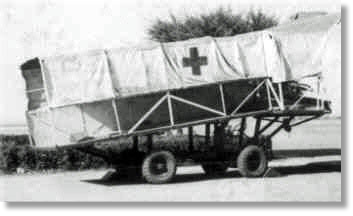
At Mauripur the UKH Hastings returning to the UK was always as a Casevac and my task was to steer the casevac ramp up to the open doors of the kite with four-coolie power and me at the steering wheel.
The ramp was built on an old 3 tonner chassis and used to unload the stretcher cases. It took a while to do it right the first few times but after a few months I got it right first time.
At Khormaksar I was on Passenger Handling and one of my tasks was organising the crew and passenger flight rations that were put up by the NAAFI for the various outgoing flights.Also for the Lincoln and later the Shackleton flights that used to take off on patrol in the early hours of the morning.
The ramp was built on an old 3 tonner chassis and used to unload the stretcher cases. It took a while to do it right the first few times but after a few months I got it right first time.
At Khormaksar I was on Passenger Handling and one of my tasks was organising the crew and passenger flight rations that were put up by the NAAFI for the various outgoing flights.Also for the Lincoln and later the Shackleton flights that used to take off on patrol in the early hours of the morning.
The movements officer was a bit of a loss. One morning I had to stop him putting the Masirah bound passengers on the flight to Eastleigh; Peter King will remember him F/Lt W----n. Good job I was there!
Cheers
John
Cheers
John
Flying belle lands role on catwalk
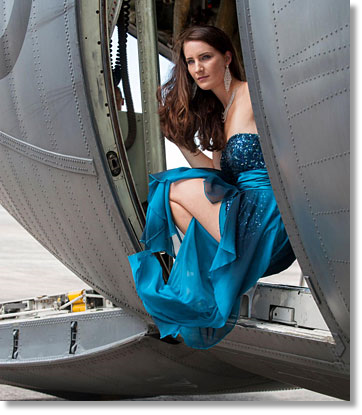
Former Marlborough Girls' College student Sergeant Sarah Anderson has travelled the world with her career.
As a flight steward on the Royal New Zealand Air Force Boeing 757 and Hercules C-130 aircraft, the 26-year-old has been all over the globe, and says the air force was the perfect career choice for her.
"I love the physicality, the flying and the people - it's just awesome," said Anderson, who now lives on Auckland's North Shore.
But the self-proclaimed tomboy could soon have a new destination after being head-hunted through Facebook for the Miss World New Zealand 2014 pageant by former beauty queen Hannah Carson.
"I'm entering as a bit of a rookie, but I'm really excited about it."
Anderson joined the air force in 2006, following in the footsteps of her father, Flight Sergeant Paul Anderson, who has been in the air force for 35 years.
Her younger sister, Leading Aircraftman Julia Anderson also recently signed up.
"I wanted to do a big overseas trip so Dad said: ‘Why don't you join the air force as a flight steward and travel the world for free?'
As a flight steward on the Royal New Zealand Air Force Boeing 757 and Hercules C-130 aircraft, the 26-year-old has been all over the globe, and says the air force was the perfect career choice for her.
"I love the physicality, the flying and the people - it's just awesome," said Anderson, who now lives on Auckland's North Shore.
But the self-proclaimed tomboy could soon have a new destination after being head-hunted through Facebook for the Miss World New Zealand 2014 pageant by former beauty queen Hannah Carson.
"I'm entering as a bit of a rookie, but I'm really excited about it."
Anderson joined the air force in 2006, following in the footsteps of her father, Flight Sergeant Paul Anderson, who has been in the air force for 35 years.
Her younger sister, Leading Aircraftman Julia Anderson also recently signed up.
"I wanted to do a big overseas trip so Dad said: ‘Why don't you join the air force as a flight steward and travel the world for free?'
"My job has taken me all over the world including Malaysia, Japan, Russia, United Arab Emirates, Antarctica, and many more."
Anderson hoped wisdom and life experiences gained in the military would carry her a long way in the Miss World New Zealand pageant.
"I just hope I can represent the air force and my family well and keep true to our values."
To support Sarah, go to her Facebook page, Sarah Anderson Miss World New Zealand Contestant 2014
Marlborough Express
Anderson hoped wisdom and life experiences gained in the military would carry her a long way in the Miss World New Zealand pageant.
"I just hope I can represent the air force and my family well and keep true to our values."
To support Sarah, go to her Facebook page, Sarah Anderson Miss World New Zealand Contestant 2014
Marlborough Express
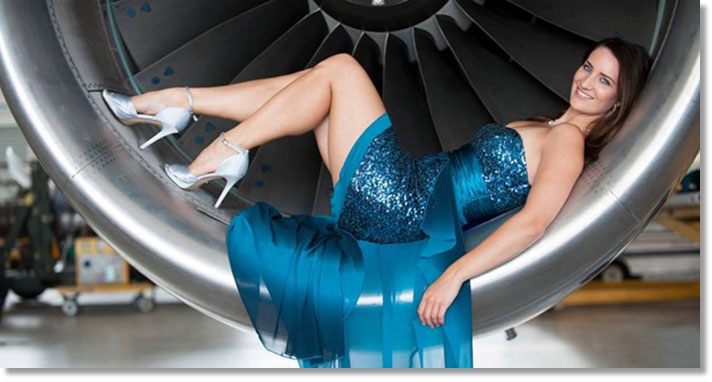
From: Barry Tappenden, Shortstown, Beds
Sent: Monday, April 14, 2014 11:53 AM
Subject: New cross for a local church
Hi Tony,
Just one of the more pleasant under-slung loads when I was on FEAF MAMS back in 1966 - especially the very elaborate meal afterwards!
Barry
Sent: Monday, April 14, 2014 11:53 AM
Subject: New cross for a local church
Hi Tony,
Just one of the more pleasant under-slung loads when I was on FEAF MAMS back in 1966 - especially the very elaborate meal afterwards!
Barry
New cross for a local church
- Delivered by Seletar Helicopter
Local newspapermen and TV camera crews had a field day recently when they turned out in force to watch a 1,000-pound aluminium and steel cross being lowered into position by one of Seletar's helicopters at the new Hakka Methodist Church in Newton Road, Singapore.
The Pastor of the church, Reverend David Wong, asked Seletar to help after learning that the cross could not be lifted into position from the ground, and remembering how RAF helicopters had picked up people from remote and confined landing places in Sarawak.
Wing Commander J. Dowling, then OC Helicopter Wing at Seletar, was the obvious choice to do the job, being one of the three pilots who, several years ago, placed a spire and sculture atop the new Coventry Cathedral.
This job involved placing an 18-foot tube into a hole in the concrete tower of the new church, with only a quarter of an inch clearance. The task, said tyhe WIng Commander, was "not partuicularly difficult." It was accomplished by a Belvedere of 66 Squadron, with the cross attached to an 80-foot cable.
FOOTNOTE
At a recent ceremony, the Bishop of Malaysia presented gold inscribed medals to the crews who took part in the operation as a token of the church's gratitude for a job well done. The medals were presented to Squadron Leader Grey (OC 66), Flight Lieutenant M. Nast, Flight Lieutenent M. Sparks, Master Signaller J. Baker and Master Engineer J. Collier. Wing Commander Dowling was not able to be present as he has now returned to the UK.
After the presentation, the crews were entertained to a Chinese dinner, and shown a film of the installation of the cross.
The Pastor of the church, Reverend David Wong, asked Seletar to help after learning that the cross could not be lifted into position from the ground, and remembering how RAF helicopters had picked up people from remote and confined landing places in Sarawak.
Wing Commander J. Dowling, then OC Helicopter Wing at Seletar, was the obvious choice to do the job, being one of the three pilots who, several years ago, placed a spire and sculture atop the new Coventry Cathedral.
This job involved placing an 18-foot tube into a hole in the concrete tower of the new church, with only a quarter of an inch clearance. The task, said tyhe WIng Commander, was "not partuicularly difficult." It was accomplished by a Belvedere of 66 Squadron, with the cross attached to an 80-foot cable.
FOOTNOTE
At a recent ceremony, the Bishop of Malaysia presented gold inscribed medals to the crews who took part in the operation as a token of the church's gratitude for a job well done. The medals were presented to Squadron Leader Grey (OC 66), Flight Lieutenant M. Nast, Flight Lieutenent M. Sparks, Master Signaller J. Baker and Master Engineer J. Collier. Wing Commander Dowling was not able to be present as he has now returned to the UK.
After the presentation, the crews were entertained to a Chinese dinner, and shown a film of the installation of the cross.
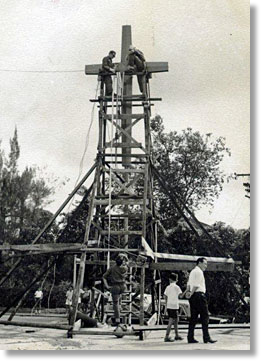
Flying Officer Hackford and SAC Tappenden, both of MAMS, make
final preparations for the lift off
final preparations for the lift off
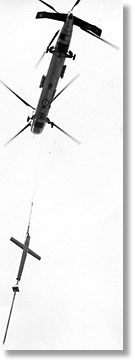
A 66 Squadron Belvedere lifts the 1000-pound cross
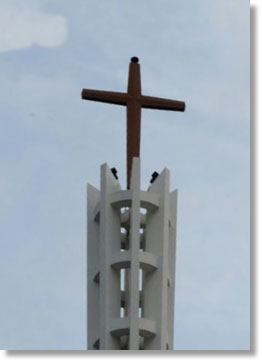
A recent photo showing the cross
atop the church's tower
atop the church's tower
From: Susan O’Regan, Paris
Sent: Monday, April 14, 2014 2:34 PM
Subject: Most difficult task
Sent: Monday, April 14, 2014 2:34 PM
Subject: Most difficult task
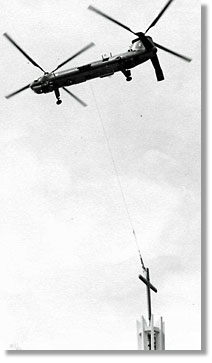
Lowering the cross onto
the church tower
the church tower
Hi Tony,
I think my one of my father’s most difficult tasks would have been the RADFAN for which he received the General Service Medal.
He often mentions it and wonders if any of the Old Bods were there at the same time as him.
All the best,
Susan O’Regan- Monneron,
daughter of John O’Regan
I think my one of my father’s most difficult tasks would have been the RADFAN for which he received the General Service Medal.
He often mentions it and wonders if any of the Old Bods were there at the same time as him.
All the best,
Susan O’Regan- Monneron,
daughter of John O’Regan
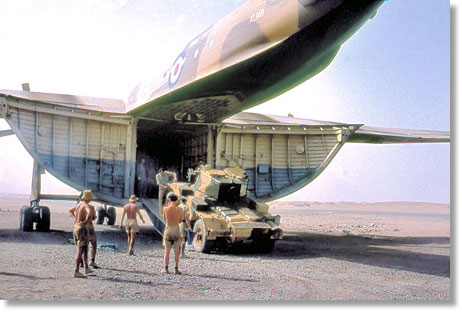
From: Terry Mulqueen, Hastings, Sussex
Sent: Monday, April 14, 2014 3:56 PM
Subject: My Most Memorable Task.
Sent: Monday, April 14, 2014 3:56 PM
Subject: My Most Memorable Task.
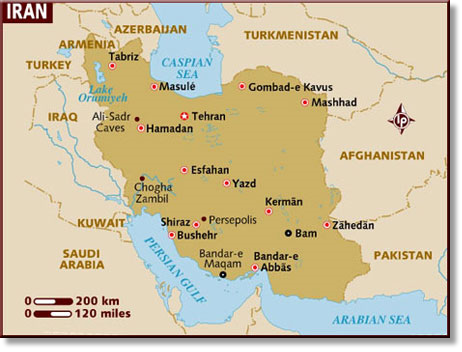
Myself and, if I remember correctly, Brian Kingdom, plus 1 (sorry mate can't remember your name), were tasked to go to Banda Abbas, Iran to recover Royal Navy diving team. Departed Heathrow on BA 888 November 20th 1977 for Bahrain.
Arrived 21st and departed 22nd on Hercules Flight 4872 to Banda Abbas, arriving that day for, at the most, a 4 day job. Accompanied by RN personnel we inspected said cargo (loaded Land Rover) made sure all OK, notified Bahrain and prepared to await Hercules to recover.
Various thing occured in the 28 (yes, 28!) days we waited, including 2 earthquakes; we knew that's what was happening when the hotel room's wall parted company with the ceiling! Next day the hotel staff were painting over the cracks in the outside wall.
We made various "friends" including American divers working with an oil company, who hadn't been paid for some time until an "oppo" flew in from the States with cash for them. Unfortunately this oppo was robbed by his Iranian driver and because he accused him of this was thrown out of the country for accusing an Iranian of theft!
Arrived 21st and departed 22nd on Hercules Flight 4872 to Banda Abbas, arriving that day for, at the most, a 4 day job. Accompanied by RN personnel we inspected said cargo (loaded Land Rover) made sure all OK, notified Bahrain and prepared to await Hercules to recover.
Various thing occured in the 28 (yes, 28!) days we waited, including 2 earthquakes; we knew that's what was happening when the hotel room's wall parted company with the ceiling! Next day the hotel staff were painting over the cracks in the outside wall.
We made various "friends" including American divers working with an oil company, who hadn't been paid for some time until an "oppo" flew in from the States with cash for them. Unfortunately this oppo was robbed by his Iranian driver and because he accused him of this was thrown out of the country for accusing an Iranian of theft!
After a couple of weeks poor old Brian had started talking to the fish in the sea (I don't think he ever recovered) it was so boring. To cut a long desperate story short, another aquaintance was a helicopter pilot for the same oil company and over a few welcome Vodka and Cokes we persuaded him to fly us to Shiraz via Hajabad in the desert. This was on Dec 18th which was a good 3 weeks after we'd given up of ever seeing a Hercules again (a reason was never given as to why we were never picked up). I did call the Group Captain Air Attache in Teheran several times but he could never help, and anyway every call was being taped by the Iranians.
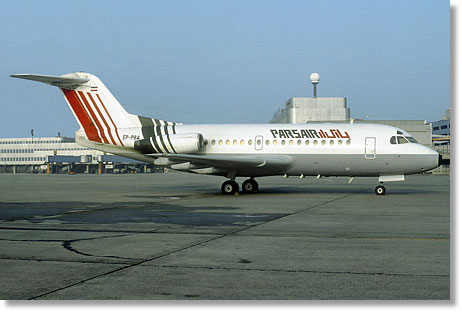
After arrival at Shiraz I managed to get us a flight on a "Pars Air" F.28 to Teheran where I contacted our friendly Group Captain who informed us that everyone was trying to leave Teheran, issued us with "open" tickets with instructions to go to the airport and try to get on a flight. After 2 days at the airport I approached a member of staff, as we had found out that a BA flight was due in from Singapore, to find out if he had a "Standby List". He didn't know what I was talking about so I showed him what that was, gave him my pen and told him to put our names on the top, at which time we leapfrogged over piles of baggage into the Departure Lounge and when the B747 landed we introduced ourselves and jumped on board.
We finally landed at Heathrow on Dec.21st and awaited transport from Lyneham. There is so much more I could recollect, but the amazing thing is that we were never told of why we were never picked up, and it took me a good month to finally persuade Accounts to pay us some allowances. I will never ever forget this task as long as I live.
Terry Mulqueen
We finally landed at Heathrow on Dec.21st and awaited transport from Lyneham. There is so much more I could recollect, but the amazing thing is that we were never told of why we were never picked up, and it took me a good month to finally persuade Accounts to pay us some allowances. I will never ever forget this task as long as I live.
Terry Mulqueen
From: David Howley, Melton Mowbray
Sent: Wednesday, April 16, 2014 4:45 AM
Subject: My Most Memorable Task
Hi Tony,
Mine is a sad one - the recovery of 4 Austrian soldiers, who had been strafed by a Turkish F-100 Super Sabre near Famagusta, Cyprus, in August 1974. I was then Sgt i/c the “Haze Team” at Brize Norton, tasked with the recovery of deceased Royalty back to the UK. I regret to say, my memory of who else was on that task is pitiful - one of those unexplainable gaps!
Sent: Wednesday, April 16, 2014 4:45 AM
Subject: My Most Memorable Task
Hi Tony,
Mine is a sad one - the recovery of 4 Austrian soldiers, who had been strafed by a Turkish F-100 Super Sabre near Famagusta, Cyprus, in August 1974. I was then Sgt i/c the “Haze Team” at Brize Norton, tasked with the recovery of deceased Royalty back to the UK. I regret to say, my memory of who else was on that task is pitiful - one of those unexplainable gaps!
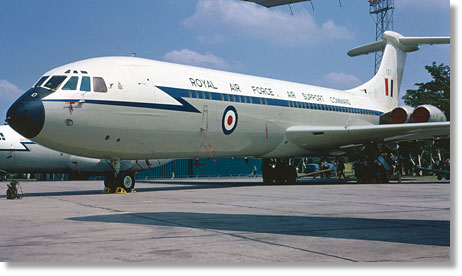
We departed Brize in a No.10 Squadron VC10, at 0500 for Vienna, where we boarded 30 or so Austrian troops on UN roulement. Departure was slightly delayed because a case of “pickled herrings” was dropped and the resultant mess and vinegar had to be cleaned from the floor - it stank!
Route was back out over N.Italy and down the Adriatic Sea to Akrotiri, arriving around lunchtime. Blues were not the most suitable dress, especially working to lash the coffins in the front hold.
We arrived back in Vienna at 2000 that evening, stopped on the taxiway whilst the Ground Eng climbed down a ladder from the front pax door, opened the forward belly hold door which we secured with a pre-laid set of strops, so that it was held recessed from the opening but not run back into the housing.
Route was back out over N.Italy and down the Adriatic Sea to Akrotiri, arriving around lunchtime. Blues were not the most suitable dress, especially working to lash the coffins in the front hold.
We arrived back in Vienna at 2000 that evening, stopped on the taxiway whilst the Ground Eng climbed down a ladder from the front pax door, opened the forward belly hold door which we secured with a pre-laid set of strops, so that it was held recessed from the opening but not run back into the housing.
For those who are familiar/unfamiliar with the VC10, access to the forward hold was possible from the main hold via the electronics bay. He hopped back on board and we taxied onto the pan and stopped parallel to the main terminal.
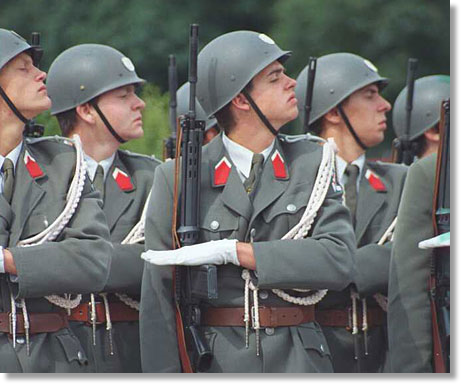
It was packed with people, the President, government, relatives and a guard of honour that would have been familiar in 1930’s Germany - it was the helmet that really struck a chord. And of course the media.
The strops were removed and the door slid slowly into the housing to reveal the foot of coffin No.1, with me on one side and my colleague on the opposite. The other two would push from the back. Each coffin had a bearer party of 6 soldiers who took the weight as the coffin was slowly moved outwards. As coffin No.4 was being slid to the door it rapidly became apparent that something was amiss - the embalming fluids had escaped the body-bag and were soaking out of the head end. Pickled herrings had nothing on that smell!
I really have a great respect and admiration for the two soldiers who took that end, I watched their hands come up to take the weight, recoil and then firmly take the coffin - could I have done that?
Unfortunately, our escape from the hold, at least for the two of us in the door was prevented by the appearance of a TV crew, who proceeded to record us for what seemed an extraordinary length of time - probably about 5 mins but it felt longer.
The strops were removed and the door slid slowly into the housing to reveal the foot of coffin No.1, with me on one side and my colleague on the opposite. The other two would push from the back. Each coffin had a bearer party of 6 soldiers who took the weight as the coffin was slowly moved outwards. As coffin No.4 was being slid to the door it rapidly became apparent that something was amiss - the embalming fluids had escaped the body-bag and were soaking out of the head end. Pickled herrings had nothing on that smell!
I really have a great respect and admiration for the two soldiers who took that end, I watched their hands come up to take the weight, recoil and then firmly take the coffin - could I have done that?
Unfortunately, our escape from the hold, at least for the two of us in the door was prevented by the appearance of a TV crew, who proceeded to record us for what seemed an extraordinary length of time - probably about 5 mins but it felt longer.
After we had slid the door into closed position (later locked externally by the GE) we “escaped” into the main hold, where everyone was complaining about the smell. I suggested that a visit to the belly hold would give them real cause to complain!
Volunteers to go back down with rolls of blue paper to soak up the liquid were not forthcoming, so it fell to me - I thoroughly washed my hands afterwards but the smell appeared to linger.
Back at Brize in the early hours of the morning the Medics were given the task of fumigating the area and apparently told Eng Ops to leave the hold open. I was subsequently told, that unfortunately for one Ch.Tech., that advice was ignored and climbing into the belly hold he rapidly exited as did his breakfast!
Regards
David
Volunteers to go back down with rolls of blue paper to soak up the liquid were not forthcoming, so it fell to me - I thoroughly washed my hands afterwards but the smell appeared to linger.
Back at Brize in the early hours of the morning the Medics were given the task of fumigating the area and apparently told Eng Ops to leave the hold open. I was subsequently told, that unfortunately for one Ch.Tech., that advice was ignored and climbing into the belly hold he rapidly exited as did his breakfast!
Regards
David
From: David Stevens, Bangor
Sent: Saturday, April 19, 2014 3:30 AM
Subject: One of my memorable flights.
Hi Tony,
In November 1965, myself and team had been tasked on Exercise Sugar Cane, transporting some Royal Engineers to Belize utilizing two 47 Squadron Hastings. Our routing outbound was via Iceland, Newfoundland, and The Bahamas.
Sent: Saturday, April 19, 2014 3:30 AM
Subject: One of my memorable flights.
Hi Tony,
In November 1965, myself and team had been tasked on Exercise Sugar Cane, transporting some Royal Engineers to Belize utilizing two 47 Squadron Hastings. Our routing outbound was via Iceland, Newfoundland, and The Bahamas.
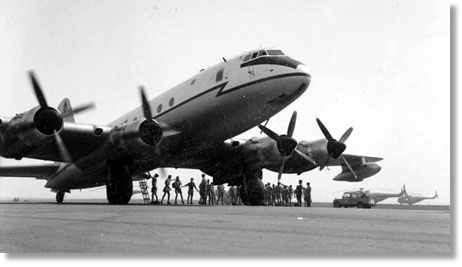
On the homeward journey our route took us via The Bahamas, Bermuda and the Azores and everything was going according to plan. The pilot out of Lajes was Wg Cdr Saunders, the 47 Squadron CO.
About 2 hours into the flight he collapsed over the stick with a heart attack!
Flt Lt Melville - a Flight Captain travelling as a pax in the back - was recovering from an almighty hang-over and was woken up. He took over. Wg Cdr Saunders was laid out on the aircraft towing arm (part of the load) that we had converted into a stretcher/bed.
Instead of going to Colerne, our original destination, we diverted into the closest UK airfield, St. Mawgan, in Cornwall. We subsequently learned that Wg Cdr Saunders made a good recovery, but stood down as CO of the Squadron.
About 2 hours into the flight he collapsed over the stick with a heart attack!
Flt Lt Melville - a Flight Captain travelling as a pax in the back - was recovering from an almighty hang-over and was woken up. He took over. Wg Cdr Saunders was laid out on the aircraft towing arm (part of the load) that we had converted into a stretcher/bed.
Instead of going to Colerne, our original destination, we diverted into the closest UK airfield, St. Mawgan, in Cornwall. We subsequently learned that Wg Cdr Saunders made a good recovery, but stood down as CO of the Squadron.
Kind regards
David
David
From: Arthur Rowland, St. Ives, Cambridgeshire
Sent: Monday, April 21, 2014 12:38 PM
Subject: My most memorable task
Hi Tony,
In 1965, a MAMS team under the control of Flying Officer John Coles (long since deceased) was entrusted with the loading of one of Her Majesty’s horses (Robespierre was his name) on an Argosy aircraft en-route to Addis Ababa. The horse was a gift from the Queen to His Highness the Emperor Haile Selassie.
Sent: Monday, April 21, 2014 12:38 PM
Subject: My most memorable task
Hi Tony,
In 1965, a MAMS team under the control of Flying Officer John Coles (long since deceased) was entrusted with the loading of one of Her Majesty’s horses (Robespierre was his name) on an Argosy aircraft en-route to Addis Ababa. The horse was a gift from the Queen to His Highness the Emperor Haile Selassie.
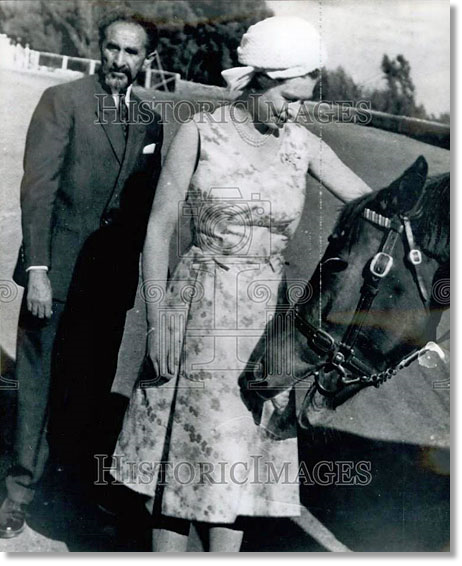
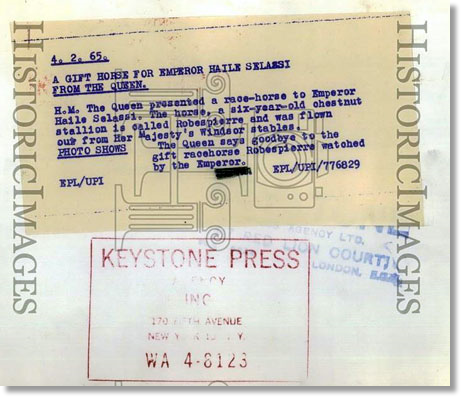
The precursor of the move was itself not without interest, as John and I (I was then the team sergeant, as Chas Cormack will probably recall) had to have meetings with the palace staff to organise the move.
The animal was expected to receive VIH status and the palace minions were not overly impressed when I insisted that a humane killer had to be made available for the duration of the flight. They thought, of course, that we might be going to shoot the horse, but as all movers will know it was only the air load master on whom we had our sights.
All was organised and the team duly departed to Gatwick Airport by road, fully loaded with hand-held shields, which the horsey set assured us would be needed to form a barricade to get the horse to go up the steps of the Argosy aircraft.
The animal was expected to receive VIH status and the palace minions were not overly impressed when I insisted that a humane killer had to be made available for the duration of the flight. They thought, of course, that we might be going to shoot the horse, but as all movers will know it was only the air load master on whom we had our sights.
All was organised and the team duly departed to Gatwick Airport by road, fully loaded with hand-held shields, which the horsey set assured us would be needed to form a barricade to get the horse to go up the steps of the Argosy aircraft.
All went reasonably well, the horse arrived, was taken out of its box and led quietly to the steps of the Argosy.
Those of you who know this aircraft well will recall that it was a rear-loading aircraft with gaping jaws and a reasonably steep ramp and, not surprisingly, Robespierre did not much like the idea of being eaten by, what must have looked like to him, a fairly large crocodile.
We duly positioned the MAMS airmen holding the shields by each side of the ramp. Flying Officer Coles and I stood back and the handler led the horse forward. He got as far as getting the two front legs of the horse on the bottom of the ramp, but Robespierre decided that the APU was not to his liking, heeled quickly to the right, booted one of the airmen (I think it might have been young Gibson) and then made off at great speed, and much faster than the ones I occasionally put my money on at Newmarket, in the direction of the runway.
Those of you who know this aircraft well will recall that it was a rear-loading aircraft with gaping jaws and a reasonably steep ramp and, not surprisingly, Robespierre did not much like the idea of being eaten by, what must have looked like to him, a fairly large crocodile.
We duly positioned the MAMS airmen holding the shields by each side of the ramp. Flying Officer Coles and I stood back and the handler led the horse forward. He got as far as getting the two front legs of the horse on the bottom of the ramp, but Robespierre decided that the APU was not to his liking, heeled quickly to the right, booted one of the airmen (I think it might have been young Gibson) and then made off at great speed, and much faster than the ones I occasionally put my money on at Newmarket, in the direction of the runway.
We then spent the next hour and a half waiting patiently while the palace staff raced up and down the main runway at Gatwick trying to catch Robespierre. Naturally, of course, flying from Gatwick was stopped for the period and the MAMS team undertook their usual activity of mushroom hunting or card-playing.
The horse was eventually caught, by which time he was a pretty tired creature and we got him back to the bottom of the ramps again.
This time, having dispensed with the so-called shields and with the APU switched off, he quietly went aboard, probably following a large carrot.
Oh, as an off-shoot, this incident made page 3 or 4 of the Daily Express the next day. Are you surprised?
All the best
Arthur
The horse was eventually caught, by which time he was a pretty tired creature and we got him back to the bottom of the ramps again.
This time, having dispensed with the so-called shields and with the APU switched off, he quietly went aboard, probably following a large carrot.
Oh, as an off-shoot, this incident made page 3 or 4 of the Daily Express the next day. Are you surprised?
All the best
Arthur
Flying on the Last Royal Air Force Lockheed L1011 Tristar Refueling Sortie
This story was written by Graham Dinsdale for AirlineReporter
After the usual morning routine I was out the door by 4:30 a.m., and starting my car for the two-and-a-half hour drive across the countryside of Cambridgeshire, Northamptonshire, and Oxfordshire to the RAF’s huge air transport base at RAF Brize Norton.
I anticipated possible delays due to dense fog and mist covering most of the route, and the morning rush-hour road traffic around the university town of Oxford didn’t help, so I allowed plenty of time to get to the rendezvous point: an off-base car park a quarter of a mile from the station’s main gate.
For those not familiar with British nomenclature, the RAF have “stations” not “air bases!” The fog and road traffic was not as bad as the internet advised, so I arrive early, at 6:25. Time to open up the flask of coffee and munch a biscuit. Over the next 90 minutes more and more of the invited media, and some very lucky aviation enthusiasts, arrived.
I anticipated possible delays due to dense fog and mist covering most of the route, and the morning rush-hour road traffic around the university town of Oxford didn’t help, so I allowed plenty of time to get to the rendezvous point: an off-base car park a quarter of a mile from the station’s main gate.
For those not familiar with British nomenclature, the RAF have “stations” not “air bases!” The fog and road traffic was not as bad as the internet advised, so I arrive early, at 6:25. Time to open up the flask of coffee and munch a biscuit. Over the next 90 minutes more and more of the invited media, and some very lucky aviation enthusiasts, arrived.
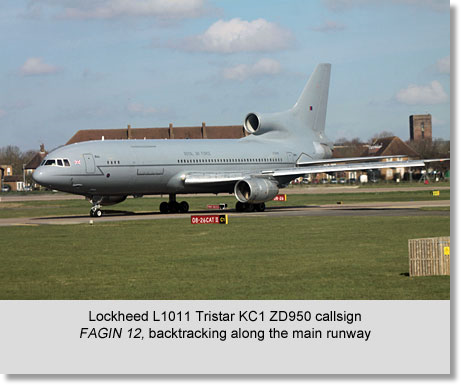
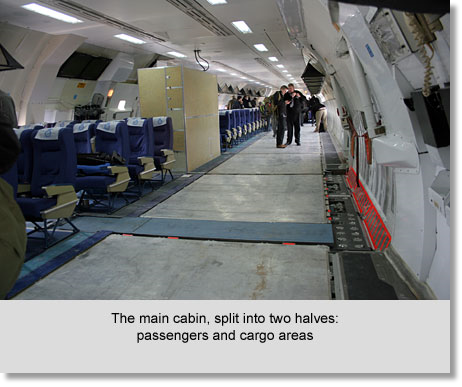
At 8 a.m., right on time, RAF Brize Norton’s Deputy Public Affairs Officer, Flight Lieutenant Rachel McCulloch, arrived and started to tick off the 40 or so names of the media who had been selected to accompany the last air-to-air refueling sortie by an RAF Lockheed Tristar, and a slightly larger number of enthusiasts who would be aboard the actual tanker.
We all board the military bus, pass through the main gate, and disembark outside the main trooping terminal known as Halfway House. It’s a big improvement since my last visit: 12 January 1974, when I flew to RAF Akrotiri on Cyprus in a 99 Squadron Bristol Britannia!
We all board the military bus, pass through the main gate, and disembark outside the main trooping terminal known as Halfway House. It’s a big improvement since my last visit: 12 January 1974, when I flew to RAF Akrotiri on Cyprus in a 99 Squadron Bristol Britannia!
04:00 GMT (Greenwich Mean Time); my bedside alarm clock shatters the silence and causes my wife to stir; at last, I thought, keen to get started on what promised to be an awesome - but very sad - day. I had dozed the night away, my brain too active to shut down and allow me to get any sleep. I had reasons for my lack of sleep - I was to fly on a Royal Air Force (RAF) Lockheed L1011 Tristar in formation!
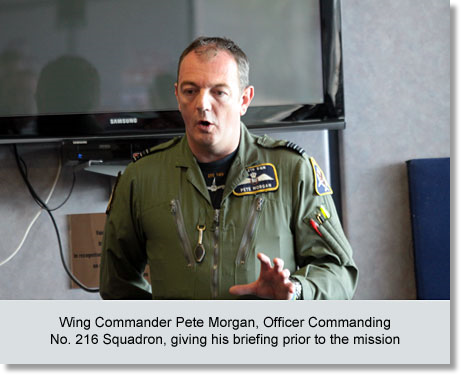
The media were told to check-in with the Air Movements Squadron personnel manning the desks, which took only a few seconds and then it was on to the security checkpoint to go into the Departure Lounge: just like any civilian airport this involved removing shoes, trouser belts, everything in pockets, jackets, computers etc.
The enthusiasts remained for the moment in the check-in area. At 9 a.m., groups of three journalists at a time were given brief private interviews with the Commanding Officer of No 216 Squadron, Wing Commander Pete Morgan. After this, we were joined by the enthusiasts, and the ‘Wingco’ who gave a presentation on the Squadron which was formed in France in 1918 - 96 years ago!
The enthusiasts remained for the moment in the check-in area. At 9 a.m., groups of three journalists at a time were given brief private interviews with the Commanding Officer of No 216 Squadron, Wing Commander Pete Morgan. After this, we were joined by the enthusiasts, and the ‘Wingco’ who gave a presentation on the Squadron which was formed in France in 1918 - 96 years ago!
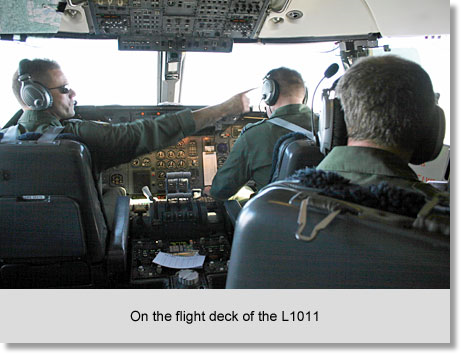
During its service, the Tristar, fondly known as ‘Timmy’ in the RAF, was the backbone of strategic air transport and air-to-air refueling, and participated in nearly every British military conflict since it entered service. The fleet of nine ex-civilian aircraft were acquired as a direct result of the Falklands war and the need to provide support to British forces in the South Atlantic, and to enlarge the air-to-air refueling fleet.
Tristars have also provided air-to-air refueling for fast jet aircraft operating over Afghanistan and Libya, and provided a vital air-bridge transporting troops and cargo to Iraq and Afghanistan. During the Iraq war, two aircraft were painted pink and were known as “Pinky” and “Perky”, after two pigs in a popular children’s cartoon series.
Tristars have also provided air-to-air refueling for fast jet aircraft operating over Afghanistan and Libya, and provided a vital air-bridge transporting troops and cargo to Iraq and Afghanistan. During the Iraq war, two aircraft were painted pink and were known as “Pinky” and “Perky”, after two pigs in a popular children’s cartoon series.
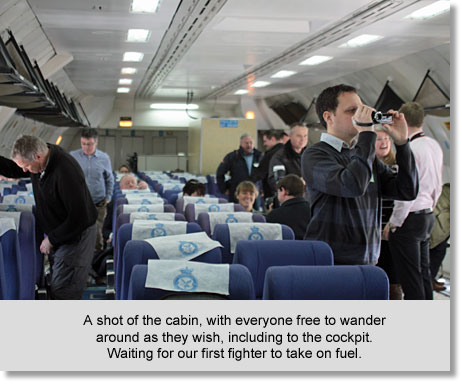
Over eight years, No 216 Squadron has flown to Afghanistan 1,642 times, carrying 250,000 passengers each way and travelling a total distance equivalent to flying around the world 640 times.
For my flight - the very last - sortie 2, KC 1 Tristar tankers (RAF serial number ZD948 and ZD950) were tasked. 948 - callsign “FAGIN 11” - did the actual air-to-air refueling with the enthusiasts aboard; ZD950 - callsign “FAGIN 12” - flew alongside with the journalists and TV crews.
Boarding the transfer coach we drove the few hundred yards to the pan where our Tristar awaits. At 10:35 we took our seats on ZD950.
Half the length of the starboard side of the cabin contains the usual airline-type seats, with the whole of the port side used as the cargo deck when carrying pallets which are loaded through the large, forward upward-hinging cargo door.
For my flight - the very last - sortie 2, KC 1 Tristar tankers (RAF serial number ZD948 and ZD950) were tasked. 948 - callsign “FAGIN 11” - did the actual air-to-air refueling with the enthusiasts aboard; ZD950 - callsign “FAGIN 12” - flew alongside with the journalists and TV crews.
Boarding the transfer coach we drove the few hundred yards to the pan where our Tristar awaits. At 10:35 we took our seats on ZD950.
Half the length of the starboard side of the cabin contains the usual airline-type seats, with the whole of the port side used as the cargo deck when carrying pallets which are loaded through the large, forward upward-hinging cargo door.
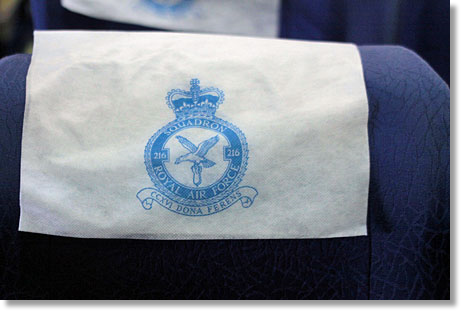
With the usual pre-departure safety briefing completed, at 10:45 the first of the three mighty Rolls Royce RB211 engines started up, and at 10:50 we pushed back. At 11:01 we started our long taxi via the eastern and southern taxiways, to the (west) end of Runway 08. At the same time, backtracking along the runway was ZD948, on our starboard side, before he turned and tucked in behind us at the threshold.
We departed first at 11:12; after a 26-second ground roll, the lightly loaded aircraft rotated and we quickly climbed and commenced a left-hand turn onto a northern heading.
We departed first at 11:12; after a 26-second ground roll, the lightly loaded aircraft rotated and we quickly climbed and commenced a left-hand turn onto a northern heading.
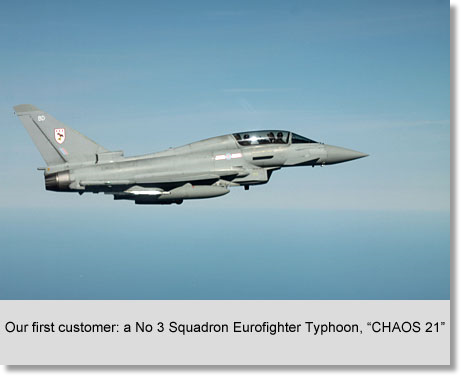
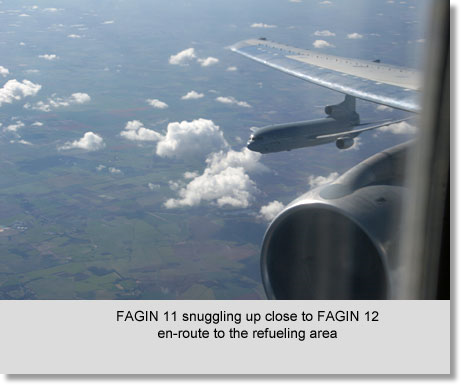
Ten minutes later, we saw “FAGIN 11” slowly gliding into view a couple hundred yards to the right and slightly below - for the next 20 minutes or so we flew in close formation as we headed north then east, out over the English coast, to the North Sea.
Our ‘destination’ was Air Refuelling Area No 8, several dozen miles off the Lincolnshire coast.
By 11:50 we had taken up the usual anti-clockwise ‘racetrack’ pattern, in the smooth, calm air at FL160, and awaited our first ‘customer’.
Our ‘destination’ was Air Refuelling Area No 8, several dozen miles off the Lincolnshire coast.
By 11:50 we had taken up the usual anti-clockwise ‘racetrack’ pattern, in the smooth, calm air at FL160, and awaited our first ‘customer’.
We did not have to wait long. Within five minutes, Typhoon “CHAOS 21” belonging to 3 Squadron appears out of the sky blue heavens and without further ado, slowly reduces the distance to the center-line mounted Hose Drum Unit (HDU) and the trailing ‘basket’.
The pilot made no mistakes in hooking up at the first attempt and the transfer of fuel commenced. The Typhoon was obviously very thirsty, and he was still ‘drinking’ 15 minutes later when we were joined by one of 15 squadron’s Tornado GR4s “LOS 86”. In the next half hour, three more Typhoons from 3 Squadron join the queue off our port side awaiting their turn: “RAMPAGE 31”, “RAMPAGE 32” and, last but not least, “TYP 21”.
The pilot made no mistakes in hooking up at the first attempt and the transfer of fuel commenced. The Typhoon was obviously very thirsty, and he was still ‘drinking’ 15 minutes later when we were joined by one of 15 squadron’s Tornado GR4s “LOS 86”. In the next half hour, three more Typhoons from 3 Squadron join the queue off our port side awaiting their turn: “RAMPAGE 31”, “RAMPAGE 32” and, last but not least, “TYP 21”.
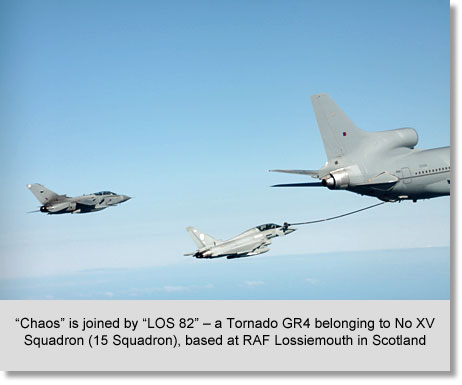
After just over an hour the air-to-air refueling part of the flight came to an end, and so too does another chapter in the history of British - and American - aviation history.
As we crossed back over the Lincolnshire coast, we went our separate ways: “FAGIN 11” conducted a flyby of Cambridge Airport - home of Marshal Aerospace which carried out heavy maintenance on the RAF’s fleet of Tristar aircraft from when they first entered service.
Then we flew over Derby, the home of Rolls Royce, the manufacturer of the Tristar’s three RB211 engines; and finally, on the southern coast of England, Bournemouth airport and the location of Cobham (an air-to-air refueling systems supplier).
As we crossed back over the Lincolnshire coast, we went our separate ways: “FAGIN 11” conducted a flyby of Cambridge Airport - home of Marshal Aerospace which carried out heavy maintenance on the RAF’s fleet of Tristar aircraft from when they first entered service.
Then we flew over Derby, the home of Rolls Royce, the manufacturer of the Tristar’s three RB211 engines; and finally, on the southern coast of England, Bournemouth airport and the location of Cobham (an air-to-air refueling systems supplier).
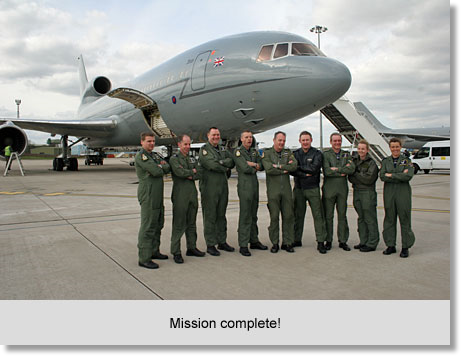
“FAGIN 11″ landed back at Brize an hour later than the media. Meanwhile, onboard “FAGIN 12” we headed back to Brize Norton; time to finally sit down and relax, pay a quick visit to the flight deck, chat with the crew, and consume our RAF lunch of sandwiches, chocolate bars, biscuits, and yogurt.
Approaching Brize Norton from the east, we “kissed” runway 26 and slowly rolled out, turned onto the southern taxiway, and made our way back to our pan passing the C-130 Hercules, C-17s Globemaster IIIs, and the Tristar’s successor, Airbus (A330) Voyagers. Engines were shutdown at 1:40 p.m.
There was no mad scramble to head for the exits; nobody talked - it was just silence as everyone reflected on what they had experienced.
Approaching Brize Norton from the east, we “kissed” runway 26 and slowly rolled out, turned onto the southern taxiway, and made our way back to our pan passing the C-130 Hercules, C-17s Globemaster IIIs, and the Tristar’s successor, Airbus (A330) Voyagers. Engines were shutdown at 1:40 p.m.
There was no mad scramble to head for the exits; nobody talked - it was just silence as everyone reflected on what they had experienced.
During the afternoon and early evening of the next day (Tuesday, March 25th), the two remaining squadron aircrews flew the first two Tristars to Bruntingthorpe: first to arrive through the low clouds and rain was Tristar C2 (ZE704) and then thirty minutes later KC1 (ZD 950) appeared through the gloom and touched down on the short runway.
With no air traffic control tower on the airfield, no airfield radar, landing lights, nor aviation aids whatsoever, any landing was going to be a challenge, but for large ‘wide-body’ Tristars the task was daunting. That said, the two 216 Squadron crews took it in stride. The plan was for another RAF aircraft to fly both crews back to Brize Norton, but when it failed to appear, the head of the squadron arranged for them to be driven back on the two hour/80 mile journey as quickly and as safely as possible, climb aboard the last two tankers, and fly them straight to Bruntingthorpe. This they did, and Tristar KC1 (ZD 948) and K1 (ZD 951) finally took off as the light began to fade. The latter was the final Tristar to land at 18:45 GMT - in the dark. With not even any approach lights, this indeed was a very professional piece of airmanship and flying.
Airline Reporter
With no air traffic control tower on the airfield, no airfield radar, landing lights, nor aviation aids whatsoever, any landing was going to be a challenge, but for large ‘wide-body’ Tristars the task was daunting. That said, the two 216 Squadron crews took it in stride. The plan was for another RAF aircraft to fly both crews back to Brize Norton, but when it failed to appear, the head of the squadron arranged for them to be driven back on the two hour/80 mile journey as quickly and as safely as possible, climb aboard the last two tankers, and fly them straight to Bruntingthorpe. This they did, and Tristar KC1 (ZD 948) and K1 (ZD 951) finally took off as the light began to fade. The latter was the final Tristar to land at 18:45 GMT - in the dark. With not even any approach lights, this indeed was a very professional piece of airmanship and flying.
Airline Reporter
On the day of the flight, there were four Tristars at Brize Norton: One was being readied for its last flight to GJD Services, a commercial scrapping company located at Bruntingthorpe airfield a few miles away (about 20 minutes flying time) which is a few miles east of Coventry; another one had arrived a few hours earlier, having flown in with British troops from Camp Bastion, at the end of their operational deployment to Afghanistan, and was being de-militarized prior to its flight to Bruntingthorpe. Additionally, there were FAGIN 11 and FAGIN 12 making their last operational flights.
RCAF Cormorant helicopter unloaded f
rom C-17 at Peru airport
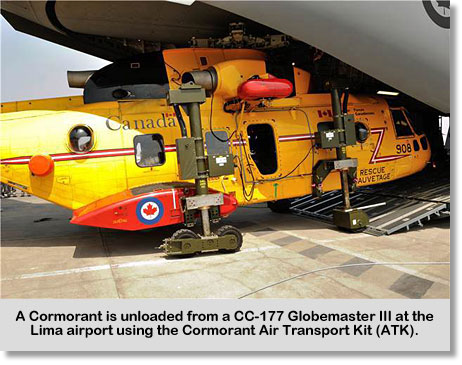
Aircrews from the Royal Canadian Air Force (RCAF) have deployed to Peru to take part in Exercise Cooperación III, a key Latin American multinational exercise. The exercise, which has a focus on disaster relief, is taking place from April 19 to May 2, 2014.
This deployment highlights two milestones for the RCAF: it is the first time a CH-149 Cormorant has been transported by a CC-177 Globemaster III and it is the first time a Cormorant has been deployed outside of North America.
The exercise will test the air-transportability of the helicopter in an expeditionary setting to simulate response to an international crisis. In addition to testing the air-transportablity of the Cormorant via the Globemaster, the RCAF will conduct air expeditionary training, search and rescue, and humanitarian aid delivery training.
“This is the first time a Cormorant helicopter will be transported by a CC-177,” said Colonel Jim Benninger, commander of the RCAF Air Task Force. “Cormorant crews have demonstrated time and again that they can help those in need at home, and through this exercise, Canadians can be proud to know that we are demonstrating our ability to help those in need abroad.”
This deployment highlights two milestones for the RCAF: it is the first time a CH-149 Cormorant has been transported by a CC-177 Globemaster III and it is the first time a Cormorant has been deployed outside of North America.
The exercise will test the air-transportability of the helicopter in an expeditionary setting to simulate response to an international crisis. In addition to testing the air-transportablity of the Cormorant via the Globemaster, the RCAF will conduct air expeditionary training, search and rescue, and humanitarian aid delivery training.
“This is the first time a Cormorant helicopter will be transported by a CC-177,” said Colonel Jim Benninger, commander of the RCAF Air Task Force. “Cormorant crews have demonstrated time and again that they can help those in need at home, and through this exercise, Canadians can be proud to know that we are demonstrating our ability to help those in need abroad.”
The Globemaster is from 429 Transport Squadron at 8 Wing Trenton, Ontario, and the Cormorant is from 413 Transport and Rescue Squadron at 14 Wing Greenwood, Nova Scotia. Also participating in the exercise is a CC-130J Hercules from 426 Transport Training Squadron at 8 Wing as well as crews from 9 Wing Gander, Newfoundland and Labrador, and 19 Wing Comox, British Columbia.
Ottawa Citizen
Ottawa Citizen
Country's First RAF Radio Station Hits Airwaves
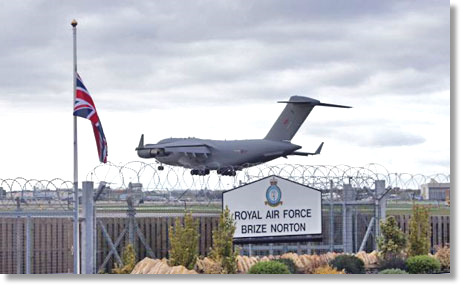
The country’s first Royal Air Force (RAF) radio station went live from Brize Norton recently. The British Forces Broadcasting Service (BFBS) station includes local and military news, music and feature programmes from across the world. It can be heard on its own base, as well as in RAF Benson, RAF Fairford and force locations in Abingdon, Didcot and Shrivenham.
RAF Brize Norton station commander Stephen F Lushington said: “I think BFBS Brize Norton is going to open many avenues and we’ll be able to have a lot of fun.
“It’s important for the local community and the families, as we can keep them up to speed on messages and announcements for the station. We have nearly 500 people deployed on operations at any given time from Brize Norton, so there’s an awful lot of families out there who want to know what’s happening on the station.”
“It’s important for the local community and the families, as we can keep them up to speed on messages and announcements for the station. We have nearly 500 people deployed on operations at any given time from Brize Norton, so there’s an awful lot of families out there who want to know what’s happening on the station.”
Presenters include Alex Gill, who has moved from BFBS Gibraltar, and ex-BBC Oxford broadcaster Jo Thoenes. Mr Gill, who will host the breakfast show from 6.30am to 10am, said: “I love how BFBS links the Armed Forces community around the world.”
There are radio stations for British forces in countries including Afghanistan, Germany and Cyprus, as well as at military bases including Catterick and Aldershot.
The station can be heard on DAB digital radio at bfbs.com/brizenorton
The Oxford Times
There are radio stations for British forces in countries including Afghanistan, Germany and Cyprus, as well as at military bases including Catterick and Aldershot.
The station can be heard on DAB digital radio at bfbs.com/brizenorton
The Oxford Times

1973, Villa Franca Airbase, Italy: Alpha team was led by Tony Willis. Whilst they were there, SAC’s Jim Marchant and ‘Boot’ Pratt decided to play a prank on the sprog officer.
From a passing bomb trolley they acquired a 3 kg ‘BOMBA PRACTISE’ and placed it in the team leader’s holdall. This remained undiscovered, the task ended and the team returned to the UK. Tony suspected his bag was unusually heavy but merely thought that the ‘lads’ had placed tensioners in there as they had done before.
On the coach back to Abingdon, he decided to call their bluff and reached into his bag to remove the tensioners. The look of sheer horror on his face as he pulled out a bomb was a joy to behold!
The trophy ended up in the crew room and eventually moved to RAF Lyneham with the squadron in 1974.
From a passing bomb trolley they acquired a 3 kg ‘BOMBA PRACTISE’ and placed it in the team leader’s holdall. This remained undiscovered, the task ended and the team returned to the UK. Tony suspected his bag was unusually heavy but merely thought that the ‘lads’ had placed tensioners in there as they had done before.
On the coach back to Abingdon, he decided to call their bluff and reached into his bag to remove the tensioners. The look of sheer horror on his face as he pulled out a bomb was a joy to behold!
The trophy ended up in the crew room and eventually moved to RAF Lyneham with the squadron in 1974.
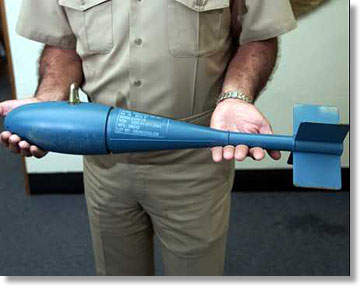
However, this is not the end of the story. Several years later, after attending an explosives course, a sergeant (who will remain nameless), discovered that the bomb was ‘live’ and, had the pin been removed, the UKMAMS would have been forced to move to several locations scattered across the airfield!
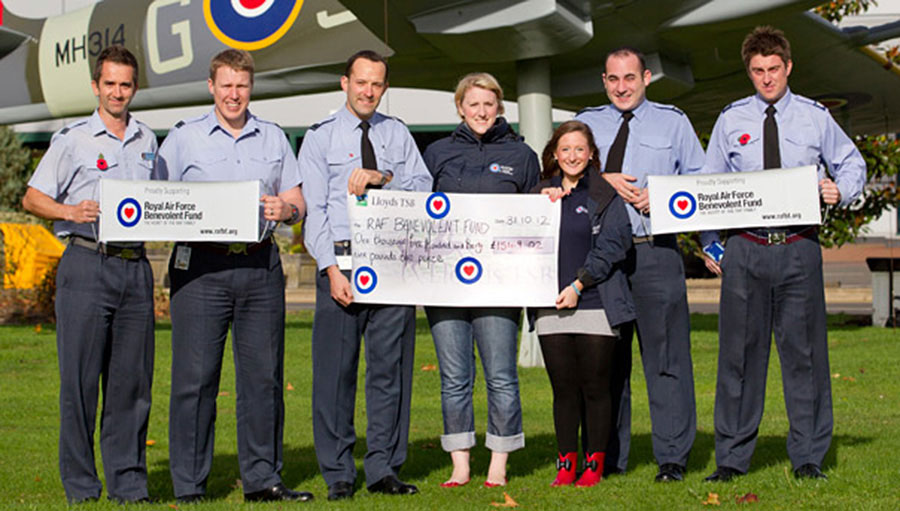
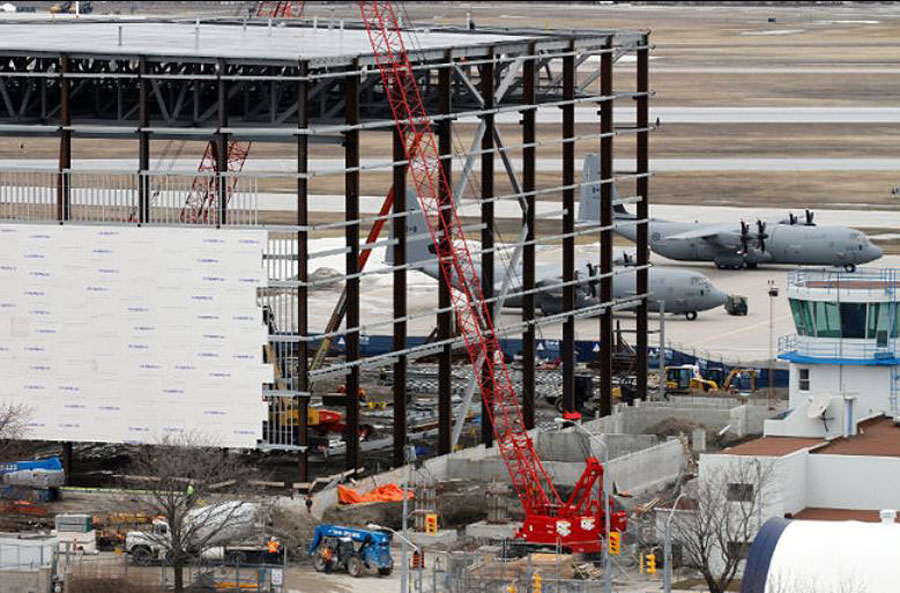
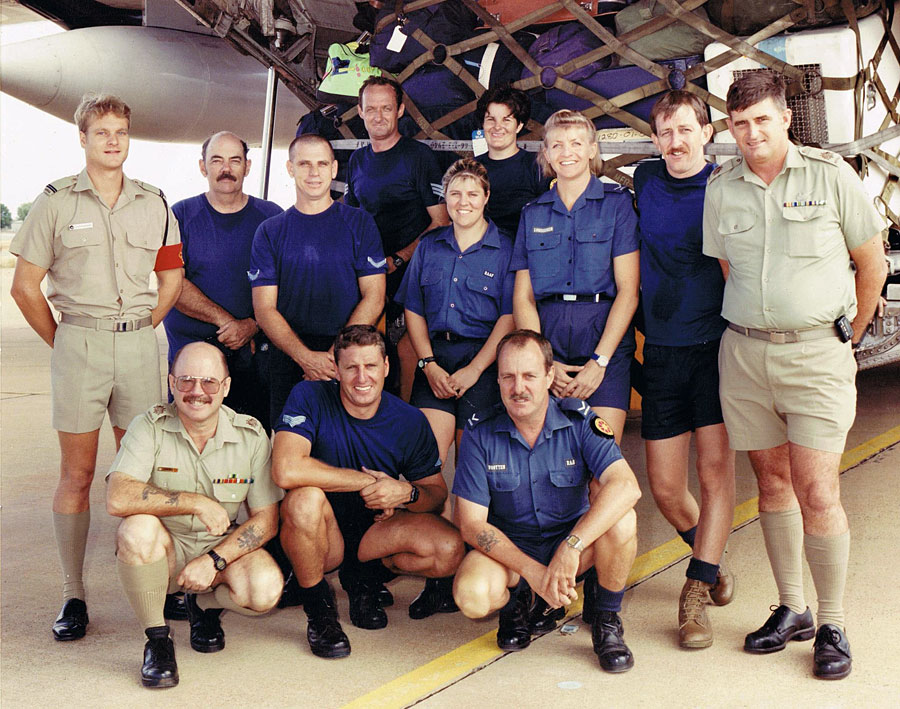
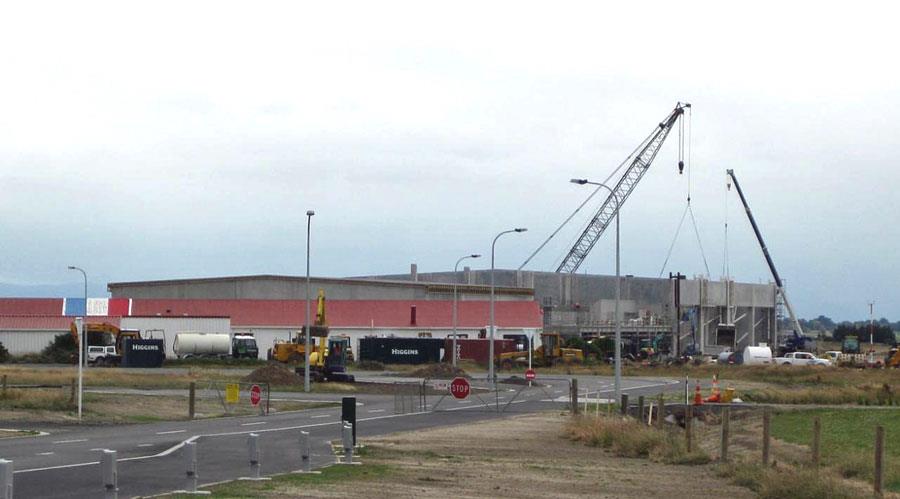
This edition is dedicated
to the memory of
Neil Mackay
to the memory of
Neil Mackay












